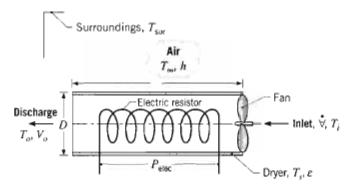A hair dryer may be idealized as a circular duct through which a small fan draws ambient
Question:
A hair dryer may be idealized as a circular duct through which a small fan draws ambient air and within which the air is heated as it flows over a coiled electric resistance wire.
 (a) If a dryer is designed to operate with an electric power consumption of Pelec = 500 W and to heat air from an ambient temperature of Ti = 20°C to a discharge temperature of To = 45°C, at what volumetric flow rate ∀ should the fan operate? Heat loss from the casing to the ambient air and the surroundings may be neglected. If the duct has a diameter of D = 70 mm, what is the discharge velocity V. of the air? The density and specific heat of the air may be approximated as p = 1.10 kg/m3 and cp = 1007 J/kg. K, respectively.
(a) If a dryer is designed to operate with an electric power consumption of Pelec = 500 W and to heat air from an ambient temperature of Ti = 20°C to a discharge temperature of To = 45°C, at what volumetric flow rate ∀ should the fan operate? Heat loss from the casing to the ambient air and the surroundings may be neglected. If the duct has a diameter of D = 70 mm, what is the discharge velocity V. of the air? The density and specific heat of the air may be approximated as p = 1.10 kg/m3 and cp = 1007 J/kg. K, respectively.
(b) Consider a dryer duct length of L = 150 mm and a surface emissivity of ɛ =0.8. If the coefficient associated with heat transfer by natural convection from the casing to the ambient air is h = 4 W/m2. K and the temperature of the air and the surroundings is T∝ = Tsur = 20°C, confirm that the heat loss from the casing is, in fact, negligible. The casing may be assumed to have an average surface temperature of Ts=40°C.
Step by Step Answer:

Fundamentals of Heat and Mass Transfer
ISBN: 978-0471457282
6th Edition
Authors: Incropera, Dewitt, Bergman, Lavine





